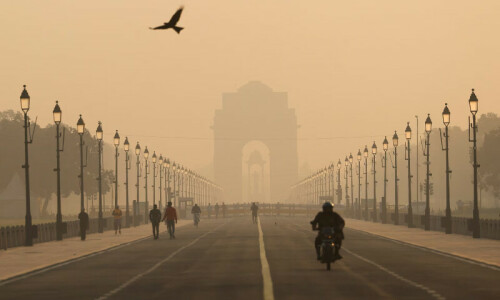
LONDON: When the clocks strike midnight in New Delhi on Jan. 12, India will mark the first year in history it has recorded no new cases of polio.
It's a huge milestone for a country many experts thought would be the last place on earth to get rid of the crippling virus. And it's an exciting step forward for global health workers battling to make polio only the second human infectious disease after smallpox to be eradicated.
“If all the data comes in clear over the next few weeks, then India, for the first time, will show up as an unshaded area on WHO polio maps,” said Sona Bari of the World Health Organisation's (WHO) Global Polio Eradication Initiative.
“This is a great start to the year for India.”
But while India celebrates, global health authorities are debating how to reduce the risk that vaccines containing live viruses may reintroduce the disease to places only just becoming polio-free.
It's a tricky judgment of timing, risk and cost, but the fact it's being discussed is a sign of how far the polio fight has come.
CRIPPLING DISEASE A disease that until the 1950s also crippled thousands every year in rich nations, polio attacks the nervous system and can cause irreversible paralysis within hours of infection.
It often spreads in areas with poor sanitation - a factor that helped it keep a grip on India for many decades - and children under five are the most vulnerable. But it can be stopped with comprehensive, population-wide vaccination.
The WHO has certified polio vaccines made by GlaxoSmithKline, Novartis, Sanofi-Aventis, Panacea Biotec and others for use in immunisation campaigns.
India's success leaves just three countries -- Pakistan, Afghanistan and Nigeria -- where polio is still endemic, and sets an example for what could be in store for them.
“It shows we're going to get it done elsewhere,” said John
Hewko, chief executive and president of the charity Rotary International, which has spearheaded the global fight against polio for three decades.
Since the Global Polio Eradication Initiative was launched in 1988, there has been a 99 per cent reduction in polio cases worldwide.
Back then the disease was endemic in 125 countries and caused paralysis in nearly 1,000 children every day. By contrast, in the whole of 2011, there were only 620 new cases worldwide.
Experts are under no illusion that getting the three remaining endemic countries to India's zero level is a challenge that will not be overcome for several more years. But as the prospect of global eradication comes into sight, it brings a new dilemma that will be a focus of the WHO's executive board next week.
LIVE OR INACTIVATED At the heart of the issue are oral polio vaccines, which are highly effective and owe much of their success to the fact they are cheap, easy to deliver and contain live polio virus strains.
Because type 2 has already been eliminated, a three-strain oral vaccine called tOPV is being phased out in favour of a bivalent or two-strain one called bOPV which fights type 1 and type 3. But the problem remains that the viruses are live.
“Looking to the future we clearly want to get away from using oral polio vaccine (OPV) altogether - because with OPV we continue to be putting live viruses into people and into the environment,” said David Salisbury, chair of the WHO's European Certification Commission for Polio Eradication and Britain's director of immunisation.
Bari described it as a tipping point. “When the risks from the vaccine start to outweigh the risks from the wild virus, that's when we should make the decision,” she said.
There is an alternative called inactivated polio vaccine or IPV, but unlike OPV it's expensive to make and difficult to deliver because it has to be injected by trained health workers in clinics.
Most wealthy countries, like the United States and Britain, dealt with the issue by using oral polio vaccines to stop transmission and maintain that halt, then switching to inactivated polio vaccines when they were sure they had the virus beaten, Bari said.
For poorer countries with limited health services, infrastructure and resources, that won't be so easy, so research teams are looking at ways of trying to make IPV more accessible.
One option is to lower the amount of antigen needed in the vaccine by adding an adjuvant, or booster that would be cheaper. Another might be developing a way of injecting only into the skin, rather than under it, a method that would require a lower -- and therefore cheaper -- IPV dose.













































